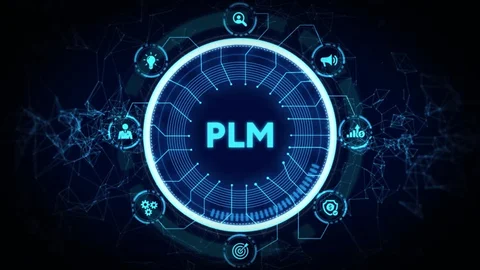TABLE OF CONTENTS
The global PLM market is a $150 billion Industry, yet much of it is still dominated by painful systems designed in the 1980s. These tools were built in a pre-cloud, pre-AI era—before agile workflows became standard, before CAD was collaborative, before tariffs and supply chain risk management became a day-to-day board-level concern.
For decades, engineers put up with PLM as a necessary evil: something mandated by leadership, not a system they wanted to use. With the rise of AI, PLM is shifting from a burdensome system of record into something more valuable: a BOM hub for manufacturing.
This digital thread unites design with sourcing, a tool engineers genuinely prefer to log into.
What Is PLM Software?
PLM (Product Lifecycle Management) software manages the data, revisions, and workflows behind every product. PLM keeps BOM management accurate, tracks every design change, and connects engineering with procurement and manufacturing.
Manufacturers use ERP systems to focus on finance and manufacturing resources, while PDM software handles file control. PLM is the tech stack’s anchor, linking design intent to procurement and production realities.
PLM is the heartbeat of hardware development, keeping every team aligned. Bill of materials are centralized, supplier data is tied directly to design decisions, and procurement gains instant visibility into engineering updates. The result: sourcing, compliance, and production all run from the same source of truth.
Why PDM is Important
PDM (Product Data Management) is often confused with PLM, but the two serve different roles. PDM focuses on controlling CAD files—managing versions, revisions, and ensuring engineers don’t overwrite each other’s work. It’s the safeguard for design teams that keeps mechanical and electrical design files organized and secure.
But stopping at PDM leaves a gap. While PDM protects the files, PLM expands that control across the product lifecycle: linking CAD data to bills of materials, procurement, compliance, and manufacturing. Without PLM, PDM remains a silo—engineering has order, but the rest of the company doesn’t see the impact of design changes.
That’s why modern platforms unify the two. A PLM that includes PDM software ensures tight engineering collaboration while still anchoring the digital thread that connects design intent with sourcing, suppliers, and production. In practice, that means CAD integrations like SolidWorks or Altium 365 surface directly into the PLM, making procurement digital and accessible in design.
Engineers Need PLM More Than Ever
Today’s hardware teams look very different from those of even a decade ago. They’re software-centric, cross-disciplinary, and moving at the same iterative pace that software engineers have long embraced. Once exclusive to code, agile workflows are now the expectation in hardware.
At the same time, the products being built for autonomous vehicles, industrial robots, and warehouse automation systems are more complex than ever. These systems blend mechanical assemblies, electronics, and software in ways that demand real-time coordination between engineering, procurement, and manufacturing. Without PLM as a central nervous system, data lives in silos, knowledge gets lost, and costs add up from delays and mistakes.
This generational shift also raises expectations for tools. Engineers no longer accept waiting months to onboard or years to see value. They expect systems to work out of the box, to be configurable without expensive consultants, and to provide real-time insights that reflect the way modern hardware is actually built.
How AI is Streamlining PLM
AI is the perfect fit for PLM because PLM is, by definition, the aggregation of multiple data sources. Hardware products combine electrical designs, mechanical assemblies, procurement data, and manufacturing processes—all of which come in different formats, languages, and workflows. Historically, making sense of that information required integrations and data translation before it could be used.
AI changes that equation. Unlike traditional systems, AI can work with information in its native format—whether CAD geometry, supplier quotes, or production schedules—eliminating the need for constant transposition. This accelerates onboarding, reduces errors, and strengthens the digital thread across every lifecycle stage. AI can even predict the impact of design changes, giving teams a head start on mitigating risks before they escalate.
This shift is critical for industries like aerospace, robotics, and industrial automation. Complex electromechanical systems depend on accurate, timely data flow across teams and suppliers. AI-enabled PLM provides real-time visibility, helping engineers and procurement make faster, smarter decisions that keep products on schedule and supply chains stable.
A PLM Built for a True Digital Thread
Seven years ago, we built Duro to give hardware engineers the tools they deserved—fast, connected, and built for how modern teams work. Fast-forward to 2025, and we’ve rebuilt that vision with the first fully AI-native PLM, embedding AI at the core to deliver a working digital thread across design, sourcing, and manufacturing.
Duro Design PLM brings that digital thread to life for complex electromechanical systems. It connects and synchronizes all product data from mechanical design to firmware and electronics, so every change is tracked and every decision is informed. Predictive change analysis flags potential impacts before they cause delays, while natural language validation rules and AI-powered sourcing balance compliance, costs, and supplier constraints.
A flexible PLM system must integrate with CAD, ERP, and MES tools. Duro Design was built API-first, ensuring that engineering teams and factory floor operators work from a single, real-time source of truth. This isn’t AI bolted onto software; it’s AI-native functionality designed with direct input from the aerospace, robotics, and industrial automation industries and partners across our ecosystem.
This type of PLM isn’t an upgrade; it’s the new standard for hardware engineering.


